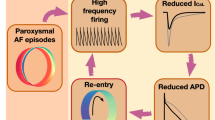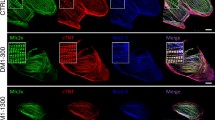Abstract
Isolated infant human atrial cells have a slower early repolarization than adult human atrial cells. In addition, from room temperature voltage-clamp studies, infant cells have lower basal L-type calcium currents than adult cells. We hypothesized that the slower repolarization increases the calcium transient of infant human atrial cells. Atrial myocytes were enzymatically dissociated from biopsies of human right atrial appendages of infant (3–8 mo) patients who were undergoing open-heart surgery. Intracellular calcium transients were measured with fluorescence microscopy with application of either square waves or action potential waveforms at physiologic temperature. After repetitive application (1 Hz) of 100-ms duration conditioning depolarizations to 10 mV (from −80 mV), a test pulse of varying duration (ΔT; 2–100 ms) produced smaller transients (expressed as percentage of the last conditioning pulse) at shorter durations (33 ± 7% for ΔT = 2 ms, 80 ± 4% for ΔT = 25 ms). With repetitive application of either adult or infant prerecorded action potentials to infant cells, the cells had a decreased calcium transient with the adult action potential (F/F0 2.2 ± 0.4 for infant action potential versus 1.6 ± 0.2 for adult action potential; n = 7; p < 0.05). The delayed early repolarization of infant cells alters the Ca2+ transient, which may compensate for the lower availability of basal calcium current in infant cells. The steep relationship that we have demonstrated between test-pulse duration and the calcium transient suggests that modulation of the early repolarization phase of the action potential may be of great significance in modulating excitation-contraction coupling.
Similar content being viewed by others
Log in or create a free account to read this content
Gain free access to this article, as well as selected content from this journal and more on nature.com
or
Abbreviations
- ΔT:
-
time step
- APD30:
-
action potential duration at 30% repolarization
- APD90:
-
action potential duration at 90% repolarization
- F:
-
fluorescence
- F0:
-
baseline fluorescence
- ICa:
-
L-type calcium current
- SR:
-
sarcoplasmic reticulum
References
Kumar R, Joyner RW 1995 Calcium currents of ventricular cell pairs during action potential conduction. Am J Physiol 268: H2476–H2486
Wagner MB, Wang YG, Kumar R, Golod DA, Goolsby WN, Joyner RW 2000 Measurements of calcium transients in ventricular cells during discontinuous action potential conduction. Am J Physiol 278: H444–H451
Sah R, Ramirez RJ, Backx PH 2002 Modulation of Ca(2+) release in cardiac myocytes by changes in repolarization rate: role of phase-1 action potential repolarization in excitation-contraction coupling. Circ Res 90: 165–173
Wang Y, Xu H, Kumar R, Tipparaju SM, Wagner MB, Joyner RW 2003 Differences in transient outward current properties between neonatal and adult human atrial myocytes. J Mol Cell Cardiol 35: 1083–1092
Escande D, Loisance D, Planche C, Coraboeuf E 1985 Age-related changes of action potential plateau shape in isolated human atrial fibers. Am J Physiol 249: H843–H850
Tipparaju SM, Kumar R, Wang Y, Joyner RW, Wagner MB 2004 Developmental differences in L-type calcium current of human atrial myocytes. Am J Physiol 286: H1963–H1969
Bers DM, Lederer WJ, Berlin JR 1990 Intracellular Ca transients in rat cardiac myocytes: role of Na-Ca exchange in excitation-contraction coupling. Am J Physiol 258: C944–C954
Cannell MB, Berlin JR, Lederer WJ 1987 Effect of membrane potential changes on the calcium transient in single rat cardiac muscle cells. Science 238: 1419–1423
Cleemann L, Morad M 1991 Role of Ca2+ channel in cardiac excitation-contraction coupling in the rat: evidence from Ca2+ transients and contraction. J Physiol 432: 283–312
Isenberg G, Han S 1994 Gradation of Ca(2+)-induced Ca2+ release by voltage-clamp pulse duration in potentiated guinea-pig ventricular myocytes. J Physiol 480: 423–438
Bers DM 2001 Excitation-contraction coupling. In: Excitation-Contraction Coupling and Cardiac Contractile Force. Kluwer Academic Publishers, Dordrecht, pp 203–244
Kato Y, Masumiya H, Agata N, Tanaka H, Shigenobu K 1996 Developmental changes in action potential and membrane currents in fetal, neonatal and adult guinea-pig ventricular myocytes. J Mol Cell Cardiol 28: 1515–1522
Kilborn MJ, Fedida D 1990 A study of the developmental changes in outward currents of rat ventricular myocytes. J Physiol (Lond) 430: 37–60
Sartiani L, Cerbai E, Lonardo G, DePaoli P, Tattoli M, Cagiano R, Carratu MR, Cuomo V, Mugelli A 2004 Prenatal exposure to carbon monoxide affects postnatal cellular electrophysiological maturation of the rat heart: a potential substrate for arrhythmogenesis in infancy. Circulation 109: 419–423
Tanaka H, Sekine T, Nishimaru K, Shigenobu K 1998 Role of sarcoplasmic reticulum in myocardial contraction of neonatal and adult mice. Comp Biochem Physiol A Mol Integr Physiol 120: 431–438
Wang L, Duff HJ 1997 Developmental changes in transient outward current in mouse ventricle. Circ Res 81: 120–127
Dobrev D, Graf E, Wettwer E, Himmel HM, Hala O, Doerfel C, Christ T, Schuler S, Ravens U 2001 Molecular basis of downregulation of G-protein-coupled inward rectifying K(+) current (I(K,ACh) in chronic human atrial fibrillation: decrease in GIRK4 mRNA correlates with reduced I(K,ACh) and muscarinic receptor-mediated shortening of action potentials. Circulation 104: 2551–2557
Li GR, Nattel S 1997 Properties of human atrial ICa at physiological temperatures and relevance to action potential. Am J Physiol 272: H227–H235
Sah R, Ramirez RJ, Kaprielian R, Backx PH 2001 Alterations in action potential profile enhance excitation-contraction coupling in rat cardiac myocytes. J Physiol 533: 201–214
Sah R, Ramirez RJ, Oudit GY, Gidrewicz D, Trivieri MG, Zobel C, Backx PH 2003 Regulation of cardiac excitation-contraction coupling by action potential repolarization: role of the transient outward potassium current (I(to)). J Physiol 546: 5–18
Bers DM 2002 Cardiac excitation-contraction coupling. Nature 415: 198–205
Bers DM 2002 Sarcoplasmic reticulum Ca release in intact ventricular myocytes. Front Biosci 7: d1697–d1711
Sun H, Oudit GY, Ramirez RJ, Costantini D, Backx PH 2004 The phosphoinositide 3-kinase inhibitor LY294002 enhances cardiac myocyte contractility via a direct inhibition of I(k,slow) currents. Cardiovasc Res 62: 509–520
Hatem SN, Sweeten T, Vetter V, Morad M 1995 Evidence for presence of Ca2+ channel-gated Ca2+ stores in neonatal human atrial myocytes. Am J Physiol 268: H1195–H1201
Chin TK, Christiansen GA, Caldwell JG, Throrburn J 1997 Contribution of sodium-calcium exchanger to contractions in immature rabbit ventricular myocytes. Pediatr Res 41: 480–485
Haddock PS, Coetzee WA, Artman M 1997 Na+/Ca2+ exchange current and contractions measured under Cl(-)-free conditions in developing rabbit hearts. Am J Physiol 273: H837–H846
Haddock PS, Coetzee WA, Cho E, Porter L, Katoh H, Bers DM, Jafri MS, Artman M 1999 Subcellular [Ca2+]i gradients during excitation-contraction coupling in newborn rabbit ventricular myocytes. Circ Res 85: 415–427
Wetzel GT, Chen F, Klitzner TS 1995 Na+/Ca2+ exchange and cell contraction in isolated neonatal and adult rabbit cardiac myocytes. Am J Physiol 268:( suppl 2) H1723–H1733
Hove-Madsen L, Llach A, Tibbits GF, Tort L 2003 Triggering of sarcoplasmic reticulum Ca2+ release and contraction by reverse mode Na+/Ca2+ exchange in trout atrial myocytes. Am J Physiol 284: R1330–R1339
Litwin SE, Li J, Bridge JH 1998 Na-Ca exchange and the trigger for sarcoplasmic reticulum Ca release: studies in adult rabbit ventricular myocytes. Biophys J 75: 359–371
Sipido KR, Maes M, Van de Werf F 1997 Low efficiency of Ca2+ entry through the Na(+)-Ca2+ exchanger as trigger for Ca2+ release from the sarcoplasmic reticulum. A comparison between L-type Ca2+ current and reverse-mode Na(+)-Ca2+ exchange. Circ Res 81: 1034–1044
Pogwizd SM, Qi M, Yuan W, Samarel AM, Bers DM 1999 Upregulation of Na(+)/Ca(2+) exchanger expression and function in an arrhythmogenic rabbit model of heart failure. Circ Res 85: 1009–1019
Studer R, Reinecke H, Bilger J, Eschenhagen T, Bohm M, Hasenfuss G, Just H, Holtz J, Drexler H 1994 Gene expression of the cardiac Na(+)-Ca2+ exchanger in end-stage human heart failure. Circ Res 75: 443–453
Armoundas AA, Hobai IA, Tomaselli GF, Winslow RL, O'Rourke B 2003 Role of sodium-calcium exchanger in modulating the action potential of ventricular myocytes from normal and failing hearts. Circ Res 93: 46–53
Dipla K, Mattiello JA, Margulies KB, Jeevanandam V, Houser SR 1999 The sarcoplasmic reticulum and the Na+/Ca2+ exchanger both contribute to the Ca2+ transient of failing human ventricular myocytes. Circ Res 84: 435–444
Flesch M, Schwinger RH, Schiffer F, Frank K, Sudkamp M, Kuhn-Regnier F, Arnold G, Bohm M 1996 Evidence for functional relevance of an enhanced expression of the Na(+)-Ca2+ exchanger in failing human myocardium. Circulation 94: 992–1002
Qu Y, Ghatpande A, el-Sherif N, Boutjdir M 2000 Gene expression of Na+/Ca2+ exchanger during development in human heart. Cardiovasc Res 45: 866–873
Bers DM 2001 Control of cardiac contraction by SR and sarcolemmal Ca fluxes. In: Excitation-Contraction Coupling and Cardiac Contractile Force. Kluwer Academic Publishers, Dordrecht, pp 245–272
Hatem SN, Benardeau A, Rucker-Martin C, Marty I, de Chamisso P, Villaz M, Mercadier JJ 1997 Different compartments of sarcoplasmic reticulum participate in the excitation-contraction coupling process in human atrial myocytes. Circ Res 80: 345–353
Author information
Authors and Affiliations
Corresponding author
Additional information
This work was partially supported by National Institutes of Health Grant HL56787 (R.K.), a Scientist Development Grant from the American Heart Association, a Biomedical Engineering Research Grant from the Whitaker Foundation (M.B.W.), National Institutes of Health Grant HL22475 (R.W.J.), The Sibley Children's Heart Center, and the Emory Egleston Children's Research Center.
Rights and permissions
About this article
Cite this article
Wagner, M., Wang, Y., Kumar, R. et al. Calcium Transients in Infant Human Atrial Myocytes. Pediatr Res 57, 28–34 (2005). https://doi.org/10.1203/01.PDR.0000148066.34743.10
Received:
Accepted:
Issue date:
DOI: https://doi.org/10.1203/01.PDR.0000148066.34743.10
This article is cited by
-
Vergleich der Calciumsensitivität und Kontraktilität von infantilen und adulten Kardiomyozyten
Zeitschrift für Herz-,Thorax- und Gefäßchirurgie (2006)



